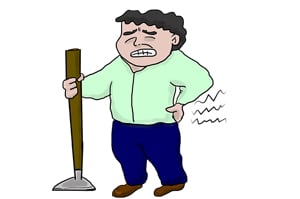
March 30, 2020
We’ve Got Your Back: Interesting New Research On Back Problems
By Michael D. Shaw
Back pain, especially that which affects the lower back or lumbar region, is the leading cause of disability worldwide. The work cited dates back to 2014, and is derived from a detailed analysis of data coming from the Global Burden of Disease 2010 study. Overall, out of 291 conditions studied, low back pain was at the top in terms of years lost to disability, and sixth in terms of disability-adjusted life years.
Not surprisingly, the prevalence and overall impact of low back pain increases with age. Thus, the authors note that “With aging populations throughout the world, but especially in low and middle-income countries, the number of people living with low back pain will increase substantially over coming decades.” The condition is more prevalent in men (10.1%) than women (8.7%).
According to the Mayo Clinic, chronic back pain is less common than the acute variety. An episode of back pain can be brought on by muscle strain; bulging or ruptured disks; or osteoarthritis which can lead to spinal stenosis. Some individuals have spinal irregularities, such as scoliosis, which can cause problems at middle age; and osteoporosis can also be a factor.
No doubt, certain human frailties can be blamed on evolution, under the banner of “gain coming with pain.” Or, to put it another way, our bodies would look somewhat different if they were purpose-designed from scratch.
Consider your foot and its 26 bones. Our ape-like ancestors needed all that structure to swing from trees, but we walk upright, and need much more rigidity, whereby the arch developed. Still, our feet have a tendency to twist in and out, resulting in ankle sprains and breaks, plantar fasciitis, Achilles tendonitis, and shin splints.
Then, there’s the human back. According to anthropologist Bruce Latimer, “If you want one place cobbled together with duct tape and paper clips it’s the back.” When humans stood upright, they took a spine that had evolved to be stiff for climbing and moving in trees and rotated it 90 degrees, so it was vertical. But so as not to obstruct the birth canal and to get the torso balanced above our feet, the spine must curve inwards (lordosis), creating the hollow of our backs. All that curving, with the weight of the head and stuff we carry stacked on top, creates pressure that causes back problems.
But wait, there’s more. A new study out of Simon Fraser University has expanded on the evolutionary argument, by examining why some people are more susceptible to spondylolysis, a vertebral defect that can lead to small stress fractures. Notably, this condition only affects humans, and not our great ape relatives.
In play here is the so-called Overshoot Hypothesis, which proposes that people develop spondylolysis because their vertebral shape is at the highly derived end of the range of variation within Homo sapiens. That is, the vertebrae have “overshot” the optimum for walking on two legs.
The researchers used advanced 3D shape analysis techniques to compare the final lumbar vertebrae of humans with and without spondylolysis to the same bones in great apes. They found that the differences between human vertebrae with spondylolysis and great ape vertebrae were greater than those between healthy human vertebrae and great ape vertebrae.
People who developed spondylolysis have vertebrae that are more wedge-shaped, where the front is taller than the back, in addition to other subtle shape differences. As researcher Mark Collard puts it: “We can picture vertebral shape variation in humans as a spectrum with one end having vertebrae with an ancestral shape and the other end having vertebrae with exaggerated bipedal adaptations. Where an individual’s vertebrae lie within this distribution has a bearing on their spinal health.”
We can only wonder about the supposed evolutionary advantage of these “exaggerated bipedal adaptations.”
